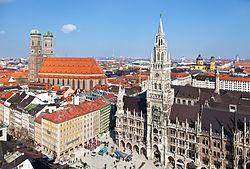Best Places to Travel in Germany 2026 – Complete Travel Explorer Guide
Discover Germany's top travel destinations for 2026, from historic cities and fairy-tale castles to scenic landscapes and cultural festivals.
EUROPE
9/22/20255 min read
Best Places to Travel in Germany 2026 – Complete Travel Explorer Guide
Introduction
Germany is a country of rich history, diverse landscapes, and vibrant culture. From medieval castles and bustling cities to scenic rivers and fairy-tale villages, Germany attracts millions of travelers each year. In 2026, Germany remains one of Europe’s top destinations, blending tradition with modernity in a way few countries can match.
Inspired by Travel Explorer, this guide will walk you through the best places to visit in Germany in 2026 — from iconic cities like Berlin and Munich to hidden gems in Bavaria, the Rhine Valley, and the Black Forest. Along the way, we’ll share practical travel tips, must-see landmarks, and insider suggestions to make your journey unforgettable.
Why Travel to Germany in 2026?
Germany continues to innovate in tourism, making travel easier, safer, and more sustainable. By 2026, visitors will enjoy:
Efficient train networks connecting major cities and scenic regions.
Digital city passes for museums, attractions, and public transport.
Vibrant festivals across regions, from Oktoberfest to cultural celebrations.
Eco-friendly travel options including electric buses and bikes in cities.
Whether you’re a history buff, foodie, or outdoor adventurer, Germany offers something for every type of traveler.
Berlin – A City of History and Modern Culture
Berlin, Germany’s capital, is a mix of history, creativity, and nightlife. In 2026, it continues to attract travelers for its museums, landmarks, and vibrant neighborhoods.
Top Attractions in Berlin:
Brandenburg Gate – The symbol of Germany’s reunification.
Berlin Wall & East Side Gallery – Historical significance combined with colorful street art.
Museum Island – Five world-class museums including the Pergamon Museum.
Reichstag Building – Visit the glass dome for panoramic city views.
Alexanderplatz & TV Tower – A bustling city center with shops and restaurants.
Travel Explorer Tip: Visit Berlin in late spring (May–June) or early autumn (September) to avoid heavy tourist crowds and enjoy pleasant weather.
Munich – Bavarian Charm and Festivals
Munich, the capital of Bavaria, is famous for its beer gardens, historic architecture, and lively festivals. It’s the perfect mix of cultural exploration and relaxation.
Must-See in Munich:
Marienplatz & Neues Rathaus – The city’s historic square with a stunning town hall.
English Garden – One of the world’s largest urban parks.
BMW Museum – For car enthusiasts and design lovers.
Nymphenburg Palace – Baroque architecture with beautiful gardens.
Oktoberfest – The world’s largest beer festival, held annually in September–October.
Travel Explorer Suggestion: Rent a bike to explore Munich’s parks, riversides, and hidden neighborhoods — it’s the best way to experience local life.
The Romantic Road – Castles, Villages & Scenic Drives
The Romantic Road (Romantische Straße) winds through southern Germany, offering storybook towns, vineyards, and medieval castles.
Highlights Along the Romantic Road:
Rothenburg ob der Tauber – A perfectly preserved medieval town.
Dinkelsbühl & Nördlingen – Charming cobblestone villages with authentic German architecture.
Neuschwanstein Castle – The fairytale castle that inspired Disney.
Würzburg – Famous for its baroque architecture and vineyards.
Travel Explorer Tip: Drive the Romantic Road in 2026 with an overnight stay in Rothenburg. Early mornings or late evenings are ideal for avoiding crowds and taking stunning photos.
The Rhine Valley – Castles and River Cruises
The Rhine Valley is one of Germany’s most scenic regions, with vineyards, cliffs, and historic castles lining the river.
Top Rhine Valley Spots:
Rhine River Cruise – A relaxing way to see castles and villages like St. Goar and Bacharach.
Lorelei Rock – A legendary cliff with panoramic views.
Bacharach – A medieval town with colorful half-timbered houses.
Rüdesheim – Known for wine tasting and cobbled streets.
Travel Explorer Suggestion: Book a river cruise in late spring or early summer to enjoy vibrant greenery and local wine festivals.
The Black Forest – Nature and Tradition
The Black Forest (Schwarzwald) is famous for dense forests, cuckoo clocks, and outdoor adventures.
Best Places to Explore:
Baden-Baden – Luxury spa town with thermal baths.
Triberg – Home of the world’s largest cuckoo clock and waterfalls.
Freiburg – A university town with a charming old town and access to hiking trails.
Titisee Lake – Perfect for swimming, paddleboarding, or a lakeside stroll.
Travel Explorer Advice: Summer is ideal for hiking, while winter offers cozy spa retreats and snow-covered landscapes.
Hamburg – The Port City with a Modern Vibe
Hamburg, Germany’s major port, blends maritime culture with contemporary attractions.
Highlights in Hamburg:
Speicherstadt & HafenCity – Historic warehouses converted into museums and cafes.
Miniatur Wunderland – The world’s largest model railway exhibit.
Elbphilharmonie – Iconic concert hall with stunning architecture.
St. Michael’s Church – Panoramic views from the tower.
Travel Explorer Suggestion: Take a harbor boat tour at sunset — the city looks magical from the water.
Dresden – Art, Architecture, and History
Dresden, the “Florence of the Elbe,” is renowned for its baroque architecture and art collections.
Must-See in Dresden:
Zwinger Palace – A masterpiece of baroque architecture.
Frauenkirche – A reconstructed church symbolizing peace and resilience.
Brühl’s Terrace – Offers beautiful views of the Elbe River.
Semper Opera House – Catch a performance if possible.
Travel Explorer Tip: Visit in spring for the best weather and fewer tourists. Combine your trip with nearby Saxon Switzerland National Park for hiking.
Cologne – Gothic Cathedrals and Vibrant Culture
Cologne is famous for its stunning cathedral, riverside charm, and lively cultural scene.
Highlights in Cologne:
Cologne Cathedral (Kölner Dom) – A UNESCO World Heritage Site and Germany’s tallest twin-spired church.
Hohenzollern Bridge – Famous for love locks and views of the Rhine.
Old Town (Altstadt) – Narrow streets with cafes, breweries, and shops.
Chocolate Museum – Fun and delicious experience for all ages.
Travel Explorer Suggestion: Sample local Kölsch beer in traditional breweries. Cologne’s beer culture is an essential part of the city experience.
Bavaria – Lakes, Mountains, and Alpine Villages
Bavaria is ideal for nature lovers and those seeking a traditional German experience.
Top Spots:
Garmisch-Partenkirchen – Skiing, hiking, and Zugspitze, Germany’s highest peak.
Lake Königssee – Crystal-clear waters surrounded by mountains.
Berchtesgaden – Stunning alpine landscapes and Eagle’s Nest history.
Mittenwald – Colorful alpine village known for violin-making tradition.
Travel Explorer Tip: Summer offers hiking and boating, while winter provides ski resorts and festive Christmas markets.
German Food & Culinary Travel in 2026
No trip to Germany is complete without tasting its culinary delights. In 2026, Germany continues to be a food lover’s paradise.
Berlin: Currywurst, Döner kebabs, street food markets.
Munich: Pretzels, Weißwurst, Bavarian beer.
Rhine & Mosel regions: Riesling wines, regional sausages, and cheeses.
Black Forest: Black Forest cake, smoked ham, and cherry desserts.
Bavaria: Roasted meats, hearty stews, and seasonal dishes.
Travel Explorer recommends joining food tours in local towns — they’re affordable and give insider access to markets, breweries, and hidden gems.
Practical Travel Tips for Germany in 2026
Language – English is widely understood, especially in cities, but learning basic German phrases helps.
Transport – Germany’s trains are excellent. Consider a German Rail Pass for multiple regions.
Currency – Germany uses the Euro (€), with contactless payments widely accepted.
Safety – Germany is generally safe, but watch your belongings in tourist-heavy areas.
Budget – Expect €60–100/day for budget travel, €150–250/day mid-range, €300+ for luxury.
Conclusion
Germany in 2026 is a country of contrasts — from bustling modern cities to serene alpine villages, from historic castles to futuristic museums, and from traditional food to cutting-edge gastronomy. Whether you’re a history enthusiast, nature lover, foodie, or festival-goer, Germany has something for everyone.
Following Travel Explorer’s advice — picking the right season, balancing iconic landmarks with hidden gems, and immersing yourself in local culture — will ensure your trip is unforgettable. Pack your bags, brush up on a few German phrases, and get ready to experience one of Europe’s most fascinating and diverse destinations.


© 2025. All rights reserved.


